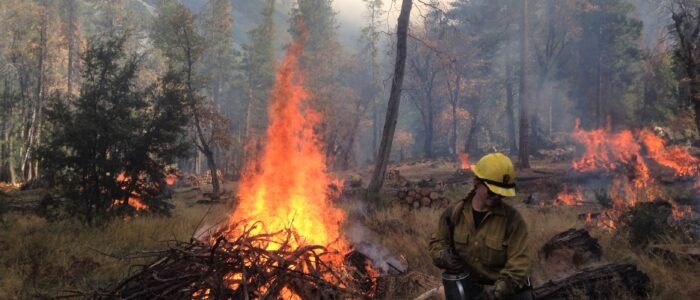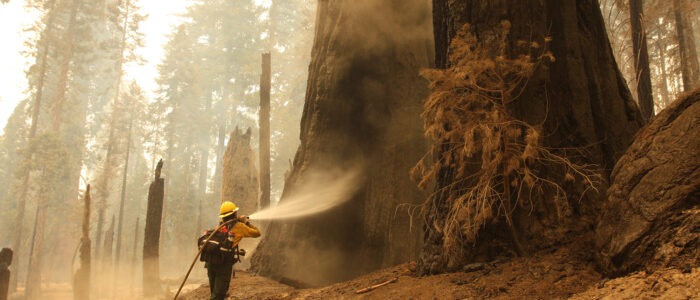Flora and Fire Management in Yosemite
“In the era of climate change fire ecology is shifting, we see behavior we’ve never seen before. We did a prescribed burn at 6200ft in January of this year, which is new.” — Dan Buckley, Yosemite Fire Chief
During the past few decades, California’s fire season has been starting earlier and finishing later. Drought has exacerbated fire conditions, creating drought-stressed flora that have transformed many of the state’s trees into kindling.
Many of Yosemite’s fires have been human-caused and preventable, sparked by dragging tire chains, hunters’ fires and through faulty power lines outside the park.
The 10 largest fires in California’s history have occurred since 2000, which coincides with a trend of longer, drier summers, and shorter, drier winters. Climate change has exacerbated this cycle, and the question now is: How can California — and particularly Yosemite — adapt to such radically shifting and unpredictable weather patterns?
The idea of “fighting” fire was developed in Yellowstone in the 1880s. The policy was implicitly incorporated into the National Parks Act of 1916, which outlawed prescribed fires. It effectively criminalized the Indigenous practice of using fire to help steward and shape the landscape that had been in existence for thousands of years.
With colonization came a violent disregard for the ways in which Indigenous populations coexisted with the land. Native sovereignty was ignored — alongside practices of using fires regeneratively — and fire suppression was widely adopted as a best practice in California.
More than 100 years later, we’re seeing the extreme downsides of this practice, and we now understand what Indigenous cultures have seemingly always known: Fire is an essential part of our ecosystems.
Yosemite’s fire records go back to 1930. But we know, ecologically, fire has always been part of the landscape. For example, sequoias germinate due to fire, as do with many other fire-adapted flora.
It was only in the 1970s, when the National Park Service noticed a decline in sequoias, that prescribed burns were reintroduced in Yosemite. This decision was informed, in part, by research following the 1955 McGee Fire, which tore through 13,000 acres and threatened Sequoia National Park. Research scientists found that fire was essential for establishing a seedbed for young seedlings to flourish; it was beneficial to many different species of flora and fauna; and it was a solid tool for preventing disease and controlling insect populations.

Burn piles smolder during a controlled fire in Yosemite Valley. The debris is collected from the forest floor by hand and also using mechanical thinning. Planned fires make up a small percentage of the hundred or so fires Yosemite experiences every year and are essential to limit megafires.
Yosemite has had great success in maintaining and managing fires since the 1970s. The park is a matrix of fire history, with older fires forming an interlocking jigsaw puzzle with newer burns. The practice of allowing some naturally occurring fires (from lightning strikes) to burn slow and low has been effective at minimizing vegetation, which in turn, provides less fuel to future fires.
But reintroducing fire after decades of suppression presents challenges. Non-native grasses are a particular issue: Both Medusahead grass and Yellowstar thistle burn hot and fast, often creating a ground corridor that fire can travel along at speed. Part of the work at recently acquired Ackerson Meadow is to remove the Medusahead grass that sits on the perimeter. The sustained drought in the park also renders the reintroduction of native grass species challenging: All flora are fighting for scant resources under these conditions. Still, Yosemite has already seen some ecosystem level change: After decades of devastating fires, Foresta is now home to shrubby oak and non-native grasses, which have grown in place of the destroyed forest that once gave the area its name.
There is no doubt about the necessity of prescribed burns to protect Yosemite. But how does the park plan both for and around fire? In other words, how do resource managers balance the need for controlled burning with preparation for unpredictable wildfire?
First, fire history and fire ecology are mapped to better understand where a prescribed burn will be successful. The ideal burn exists in an area close to land that has recently burned, so the fire cannot travel with any speed.
How do fire teams plan for them?

Firefighters cool giant sequoias during the lightning-caused Windy Fire in September 2021. So far this wildfire has destroyed more than two dozen giant sequoias. “Cooling hot spots is tedious, dirty and dangerous” says Garrett Dickman. “But all the firefighters I worked with out there said they felt honored to be working to save the big trees.”
“Some prescribed burns are planned up to five years ahead,” says Garrett Dickman, Yosemite NPS biologist.
“The fire needs to be effective. But the prescription window may only be a couple of days a year. On those days, is there good air? Do you have your compliance done? This can take six months to a year, due to endangered species and cultural artifacts. Do you have the money? Is there another fire nearby that makes this a bad idea?”
It’s a delicate balance that requires constant preparation. Mechanical vegetation-thinning work is undertaken by Dickman’s team in the park, with support from young adults working with California Conservation Corps and Indigenous groups offering support through CHIPS (Calaveras Healthy Impact Products Solutions), a nonprofit organization that provides forestry jobs in the foothills of the Sierra Nevada. More than 80% of CHIPS’ workforce are Native American, most of whom are from the Miwuk and Paiute tribes of Yosemite.
Traditional, cultural fires are happening more frequently, and several are currently planned through the Conservancy-supported Black Oaks Restoration project. This tribal-led effort to care for trees that served as a primary food source for thousands of years is one sign of the gradual return of stewardship from the park service to Indigenous groups.
“Incorporating traditional ecological knowledge and techniques that were used to help black oaks produce high-quality acorns… as well as allowing opportunities for tribal knowledge to pass from elders to youth, are some of the ways the National Park Service and Yosemite Conservancy can promote a more resilient black oak ecosystem,” says Irene Vasquez, the park’s cultural ecologist.
Mechanical thinning and burn piles are just part of fire management. Using naturally occurring lightning fires in the park is also an essential part of how the park restores ecosystems through burns. Most prescribed burns are small — fewer than 100 acres — mostly because setting 1,000-acre fires has become increasingly difficult to undertake without negatively affecting overall air quality. But it is still possible to make great progress with smaller fires. In 2020, around 9,200 acres of Yosemite were managed with controlled burns.
“We need to start treating opportunities to start a prescribed burn with the same speed as we respond to wildfires,” says Dan Buckley, branch chief of fire and aviation at Yosemite, who has been working with fire for decades. “If we don’t strike the match now, all we’re doing is putting off worse fires in the future.”
Controlled burns protect the land from megafires and serve as vital species preservation. When there is less to burn, fires run out of energy faster. When this is combined with fire management urgent response, large blazes can be extinguished with greater speed. Yosemite has reintroduced thousands of acres through prescribed fire, and the great hope is that the park continues to protect and steward the land with fire.
“There are good parts of bad fires, and bad parts of good fires,” Dickman says. “The big trees need our help. And I’m hopeful that we can do it. We know what to do and how to do it. It’s just willpower that we need to make it happen.”
By Megan Orpwood-Russell. This article first appeared in our Fall 2021 magazine.
